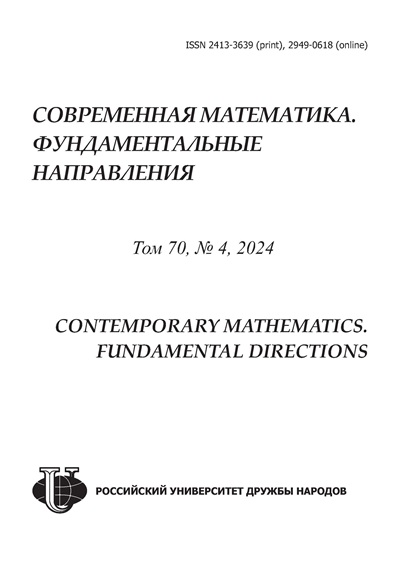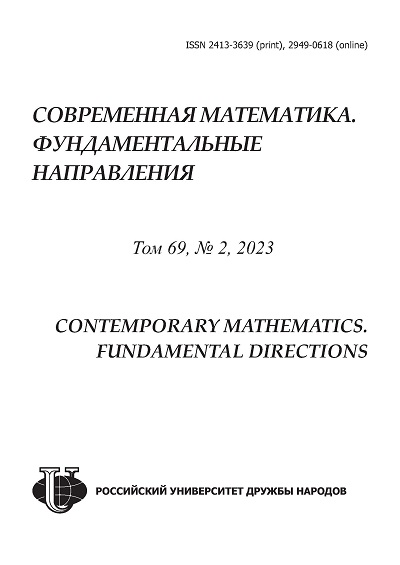Vol 69, No 2 (2023): Proceedings of the Crimean Autumn Mathematical School-Symposium
- Year: 2023
- Articles: 13
- URL: https://journals.rudn.ru/CMFD/issue/view/1671
- DOI: https://doi.org/10.22363/2413-3639-2023-69-2
Full Issue
Articles
On the existence and uniqueness of a positive solution to a boundary-value problem of the Sturm-Liouville type for a nonlinear ordinary differential equation
Abstract
Using the fixed point theorem in partially ordered sets, we obtain sufficient conditions for the existence of a unique positive solution to a boundary-value problem of the Sturm-Liouville type for a nonlinear ordinary differential equation, and give an example illustrating the results obtained.
 201-207
201-207


Numerical-analytical method for the Burgers equation
Abstract
We construct an efficient numerical-analytical method for solving the initial-boundary value problem for the Burgers equation on a segment with a periodic boundary condition. The method includes the reduction to a linear problem based on an explicit-implicit time discretization scheme and an analytical solution of an auxiliary linear problem at each time step using the explicit form of the corresponding Green’s function. The efficiency of the constructed method is due to the fact that the algorithm for solving the auxiliary problem has only linear complexity in terms of the number of spatial discretization nodes used, without involving difference approximations of the derivatives of the desired function. On the basis of the Cole-Hopf substitution, we obtain an explicit periodic solution of the problem on the interval and compare the results of the numerical implementation of the constructed algorithm with this explicit solution. The developed method demonstrated a combination of high computational efficiency and accuracy of the result.
 208-223
208-223


Research of the problem of fair distribution of fishing quotas by the methods of game theory
Abstract
Game theory emerged as a science in the second half of the 20th century. It managed to prove itself well in the analysis of economic situations involving several subjects of economic activity (players), whose interests are completely or partially opposite. At the same time, in a number of cases, the solution of the game satisfied all players, but was not the most profitable (there was a Nash equilibrium), and in a number of other cases, it was possible to take into account the interests of all parties to the maximum (there was a Pareto optimal solution). The transfer of the principles of game theory to other areas turned out to have a number of difficulties associated, among other things, with the correct interpretation of strategies and gains of the parties in a conflict situation. For this reason, despite the obvious benefit from the possible application of game theory methods to problems of a fair distribution of quotas for catching fish and other seafood, this step has not been taken until recently. In this paper, we consider a scheme for applying the algorithms of the theory of bimatrix and cooperative games on the example of solving the problem of finding the percentage of the allowable catch of the black halibut in the Barents Sea for two countries participating in the catch and give a meaningful interpretation of the results. The basis for the calculations was real data collected by the Russian-Norwegian Fisheries Commission in recent decades to determine the proportions of the catch of the indicated fish species in the respective sea zones. Since not all components of the payoff matrices of the players are uniquely determined, it became possible to perform a parametric analysis of the mathematical model of the conflict situation both in the search for an equilibrium solution and in the implementation of the arbitration scheme. The work is an extended and supplemented version of the report [2].
 224-236
224-236


Mathematical model of ideal free distribution in the predator-prey system
Abstract
We consider a system of reaction-diffusion-advection equations which describes the evolution of spatial distributions of antagonistic populations under directed migration. The concept of an ideal free distribution (IFD) for a predator-prey system is introduced. We find conditions on parameters under which there exist explicit stationary solutions with nonzero densities of both species. The numerical approach with staggered grids is used to analyze solutions in case of violation of the conditions on the coefficients that provide the IFD. We construct asymptotic expansions for an inhomogeneous one-dimensional area and present the results of a computational experiment in the case of violation of the IFD conditions.
 237-249
237-249


Mathematical expectation of the solution of a stochastic multiplicatively perturbed system of differential equations
Abstract
We consider the Cauchy problem for a first-order linear inhomogeneous system of partial differential equations with random processes as coefficients. Explicit formulas for the mathematical expectation of the solution are obtained. Examples of systems with Gaussian and uniformly distributed random coefficients are considered. An example of calculations for a simplified learning model at the microlevel is given.
 250-262
250-262


A family of piecewise-smooth solutions of a class of spatially distributed equations
Abstract
In this paper, we consider a spatially distributed equation with a periodic boundary condition and the zero integral mean condition in the spatial variable. The boundary-value problem under consideration has a family of solutions that are piecewise constant with respect to the spatial variable and have one discontinuity point. Conditions for the stability of such solutions are determined. The existence of piecewise constant solutions with more than one discontinuity point is shown. An algorithm for calculating solutions to a boundary-value problem by numerical methods is presented. A numerical analysis of the dynamics of the boundary-value problem is performed.
 263-275
263-275


Nonlinear optics problem with transformation of a spatial variable and an oblique derivative
Abstract
In this paper, we consider a functional differential equation of parabolic type on a strip with a transformation of a spatial variable and boundary conditions with an oblique derivative. Using the Laplace and Fourier transforms, we obtain a representation of the problem under consideration in the form of a nonlinear integral equation. A special case of this representation is considered. The proved statements make it possible to implement iterative methods for obtaining approximate solutions of nonlinear partial differential equations taking into account the given conditions. The results show that the presented method is promising for solving similar problems.
 276-288
276-288


Exceptional sets
Abstract
In this paper, we study sequences of complex numbers of the first order. Multiple terms are allowed for such sequences. We also consider complex sequences with a finite maximum density. We construct special coverings of multiple sets {λk,nk} consisting of circles centered at points λk of special radii. In particular, we construct coverings are with connected components of a relatively small diameter, as well as coverings that are C0-sets. These coverings act as exceptional sets for entire functions of exponential type. Outside these sets, we obtain a representation of the logarithm of the modulus of an entire function. Previously, a similar representation was obtained by B. Ya. Levin outside the exceptional set, with respect to which only its existence is asserted. In contrast to this, in this paper we present a simple effective construction of an exceptional set. We construct bases of the invariant subspace of analytic functions in a convex domain. They consist of linear combinations of eigenfunctions and associated functions (exponential monomials) of the differentiation operator divided into relatively small groups.
 289-305
289-305


On the theory of entropy suband supersolutions of nonlinear degenerate parabolic equations
Abstract
We consider a second-order nonlinear degenerate anisotropic parabolic equation in the case when the flux vector is only continuous and the nonnegative diffusion matrix is bounded and measurable. The concepts of entropy sub- and supersolution of the Cauchy problem are introduced, so that the entropy solution of this problem, understood in the sense of Chen-Perthame, is both an entropy sub- and supersolution. It is established that the maximum of entropy subsolutions of the Cauchy problem is also an entropy subsolution of this problem. This result is used to prove the existence of the largest entropy subsolution (and the smallest entropy supersolution). It is also shown that the largest entropy subsolution and the smallest entropy supersolution are also entropy solutions.
 306-331
306-331


Some inverse problems of Fourier optics
Abstract
We consider a general formulation of the problem of signal reconstruction from incomplete a priori information about it and measurements of the intensity of its Fourier transform. Some special cases are studied when a priori information is the even or odd part of the signal, as well as the real or imaginary part of the signal. Exact solutions in quadratures are constructed. An algorithm for solving the problem is proposed when only the signal and image intensities are known.
 332-341
332-341


Generalized initial-boundary problem for the wave equation with mixed derivative
Abstract
We study an initial-boundary problem for a second-order inhomogeneous hyperbolic equation in a half-strip of the plane containing a mixed derivative with constant coefficients and zero or nonzero potential. This equation is the equation of transverse oscillations of a moving finite string. The case of zero initial velocity and fixed ends (Dirichlet conditions) is considered. It is assumed that the roots of the characteristic equation are simple and lie on the real axis on opposite sides of the origin. The classical solution of the initial-boundary problem is determined. In the case of zero potential, a uniqueness theorem for the classical solution is formulated and a formula for the solution is given in the form of a series consisting of contour integrals containing the initial data of the problem. Based on this formula, the concepts of a generalized initial-boundary value problem and a generalized solution are introduced. The main theorems on finite formulas for the generalized solution in the case of homogeneous and inhomogeneous problems are formulated. To prove these theorems, we apply an approach that uses the theory of divergent series in the sense of Euler, proposed by A.P. Khromov (axiomatic approach). Using this approach, on the basis of formulas for solutions in the form of a series, the formulated main theorems are proved. Further, as an application of the main theorems obtained, we prove a theorem on the existence and uniqueness of a generalized solution of the initial-boundary problem in the presence of a nonzero summable potential and give a formula for the solution in the form of an exponentially convergent series.
 342-363
342-363


Applied theory of flexural vibrations of a piezoactive bimorph in the framework of an uncoupled boundary-value problem of thermoelectroelasticity
Abstract
In this paper, we consider transverse steady oscillations of a piezoactive bimorph in the formulation of a plane deformation. The problem is solved within the framework of linear thermoelectroelasticity, while the temperature problem is solved separately and the temperature distribution is taken into account in the constitutive relations of electroelasticity. On the basis the Kirchhoff-Love type hypothesis for mechanical quantities and a symmetric quadratic distribution of the electric potential, an approximate theory for calculating bimorph vibrations is constructed. Numerical experiments have been carried out for various cases of pinning and excitation of vibrations. The results of these experiments were compared with calculations made using the finite element method in the COMSOL package and showed the adequacy of the constructed theory in the low-frequency region.
 364-374
364-374


Evasion problem in linear parametric discrete games
Abstract
We consider the evasion problem in the formulation by Pontryagin and Mishchenko for linear discrete games depending on a parameter. We obtain sufficient conditions and domains of parameter values that ensure the solvability of the evasion problem. The obtained results are applied to the solution of the evasion problem for the well-known problem in the theory of differential games “Isotropic Rockets”-“Boy and Crocodile” in the discrete version.
 375-382
375-382












